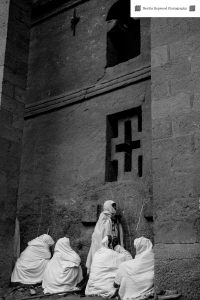It’s a common misconception that Africa has no history beyond its people scrabbling about trying to survive in a harsh environment. But there’s plenty of history in Africa
Lalibela is a wonder of the world, one which should be more widely known. It is Africa’s Petra. On a much smaller scale of course, but still comparable. The Unesco World Heritage site of Lalibela in Ethiopia is one of the most extraordinary places in the world.
It contains thirteen churches hewn or carved from the native tufa rock in imitation of buildings
In the book “A guide to Lalibela” (Arada Books, pages 16-17) can be read: “It has been said that the churches of Lalibela are the eighth wonder of the world, and it has also been said that they were built with the help of angels, so exquisitely are they chiselled in the stone. While visiting then, the language spoken by the unkown sculptors gradually becomes comprehensible, revealing important spiritual and historical meanings.
Tradition tells that King Lalibela (1185-1225) of the Zagwe Dynasty had them sculpted after a dream. Lalibela, back in his homeland after a long period of exile, reconquered the throne usurped by his brother Harbay. He became king of the region of Lasta and started his great work. It is also said that the complex is his grave.
As a matter of fact, there are no thorough studies of Lalibela to date, and research is still fragmentary and incomplete. The history and significance of these esplendid rock-hewn churches are in part unknown.”
There is a Church of the Virgin Mary here (Bet Maryam), of the Savior of the World (Bet Medhane Alem), of the Holy Cross and St.George (Bet Giorgis), of Mark and Gabriel, all of them connected by underground tunnels. King Lalibela carved them out of the mountain itself so that Muslims invading these lands could not spot them from afar. And even if they did, they could neither demolish them nor move them, because these churches constitute an integral part of the mountain.
The churches are carved from beautiful red volcanic rock, which looks particularly stunning early in the morning or late in the afternoon when the orange of the sun plays with the colours and picks out some wonderful swirling patterns.
As legend has it, the site was founded in the 13th century by King Lalibela, ruler of a newly united kingdom a number of centuries after the fall of the sacred capital Aksum. However, nothing of its accepted or assumed history can be regarded as certain. Lalibela and the Ethiopian kingdom remained unknown to the West during the period of the Crusades and first came to western notice when its ruler sent an embassy to Portugal at the beginning of the 16th century.


























